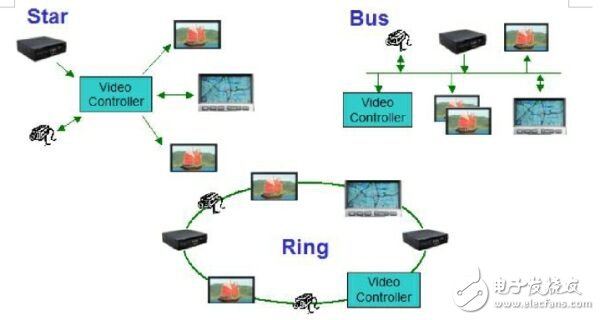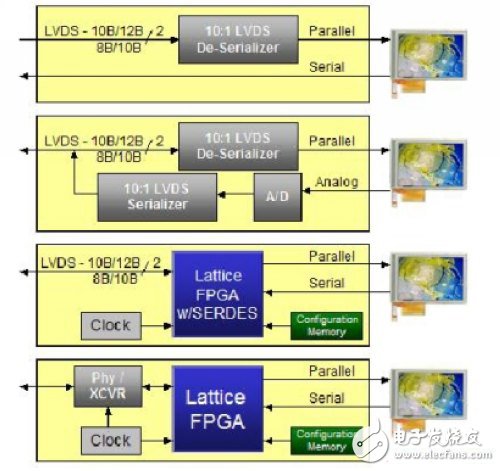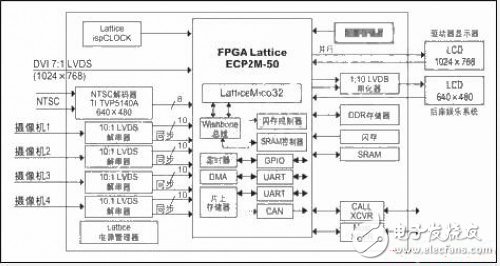Electronic devices are rapidly evolving, especially in automotive display systems, where video and video processing is becoming a fast-growing technology in automotive applications. Such as lane keeping, driving monitoring, night vision and car entertainment equipment are typical application requirements.
When designing a car video system, it is necessary to consider several aspects of the system structure: first, the function of the system, it should be determined whether the system is for the security system to process video information, or the car entertainment device to process the flowing video data, or a combination of the two. And design. The second is the type of interconnect and the speed of the video system device. In addition, other factors should be considered, including how many video sources, how many display outputs, how far different devices are in the system, which cabling scheme to use, and the cost of the entire system. Due to the high level of integration and flexibility of programmable devices, as well as low power consumption and a wide operating temperature range, and the ever-decreasing price, such devices are becoming increasingly attractive to engineers engaged in automotive electronics design. This article will focus on how to design a vehicle display system using LatTIce's programmable devices.
Interconnection of electronic devices
In automotive electronics, the interconnection of various information sources can take several topologies, namely star, bus and ring structures. These topologies are shown in Figure 1. The star structure is a one-to-one connection system with external devices connected to one port of the video controller. The communication channel can be bidirectional or unidirectional.

Figure 1: Several topologies for the interconnection of automotive electronics.
The bus type structure is point-to-multipoint and a single device can be connected to the bus. Devices on the bus must have local controllers that coordinate when and how the devices on the bus communicate. This type of system is easy to extend because each device has a unique address.
Each device in the ring structure has a unique address, in addition to a local data controller and a media transceiver for connecting to the ring. When the display device transceiver receives the information of the previous device, it looks at its own address in the data packet. If the address matches, it processes the data or the command. If the address does not match, the data packet is transmitted to the next one in the ring. equipment. In order to enable audio and video packets to be transmitted by various devices, the car ring bus for entertainment is designed to have a high bandwidth so that the viewer can watch it in real time. As can be seen from Figure 1, a video controller is required regardless of the structure.
Image capture and display
Effectively ensuring image capture and processing is important, and several solutions are described below. In several examples of the intelligent image capture system shown in Figure 2, information is communicated from the vehicle's multimedia bus to the video controller. A ring or bus structure of the MOST and D2B protocols is commonly used.

Figure 2: Three intelligent image capture systems with different processing devices.
In these three examples, the MT9V111/125 is an image sensor for automotive applications. Example 1 employs a microprocessor-based system for control and video data processing before data is sent to the interface of the display subsystem. Example 2 uses a flash-based, low-cost CPLD to process video. Example 3 uses an SRAM-based FPGA device. In all of the above examples, the transmitted information is processed by the processing unit. Among them, the programmable logic devices used in the latter two examples demonstrate the flexibility of reconfiguring hardware. In particular, Example 3 uses LatTIce's microprocessor core LatTIceMico8 in the FPGA, which allows for greater flexibility.
One method of transmitting captured images is to convert the parallel video data into a serial stream and transmit it over a single pair twisted pair LVDS interface using 8b/10b encoding. This interface embeds the clock into the data stream, reducing the number of wires required to transmit the signal to the video controller. At the receiving end, the system needs to process the data in order to return to its original form. Figure 3 is an example of four LCD displays. The first three examples all use SERDES circuits to convert signals, and Example 3 uses an SRAM-based FPGA with integrated SERDES functionality. In this case, the LatTIceECP/ECP2 FPGA is used. Since the key timing parameters are embedded in the device, the designer does not have to spend a lot of time and effort to complete this task.

Figure 3: LCD display.
The LatticeECP2 and LatticeECP2M families redefine low-cost FPGAs with more outstanding FPGA features at lower cost. These devices contain sysDSP blocks and engineering pre-fabricated source-synchronous I/O. The LatticeECP2M has up to 5.3Mb of RAM blocks and the LatticeECP2 has up to 1.1Mb of RAM blocks. The LatticeECP2M also features 3.125Gbps embedded SERDES supporting PCI Express, Ethernet (1GbE and SGMII) and several other standards. By integrating the features and performance previously only available in high-cost, high-performance FPGAs, these families extend the reach of low-cost FPGAs.
The LatticeMico32 is a 32-bit RISC soft microprocessor optimized for Lattice FPGAs. If the LatticeECP2M is combined with the open source LatticeMico32 soft processor, the LatticeECP2M can implement full video controller functionality (see Figure 4). The internal peripherals communicate via the dual WISHBONE bus. Timers, DMA, memory controllers, general purpose I/O, serial peripheral interfaces, and UARTs can all be connected to the LatticeMico32.

Figure 4: Implementing full video controller functionality with the LatticeECP2M and LatticeMico32.
Summary of this article
Because of their reconfigurable features, programmable devices are ideally suited to handle a variety of changes, such as constantly changing standards and emerging standards, and to quickly implement new standards. In addition, programmable devices have the advantages of low cost and long life cycle, which can meet the requirements of the electronic equipment in the car and the life of the car. Designers are also easy to upgrade, maintain and update the product.
8Pt Low Voltage Switch Cabinet
General Electric Switchgear,Switchgear And Transformer,Eaton Low Voltage Switchgear,Epe Switchgear
Shandong Shunkai electrical equipment co., LTD. , https://www.chinasdsk.com